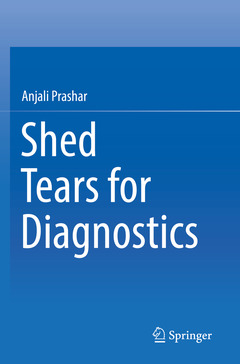Shed Tears for Diagnostics, 1st ed. 2019
Auteur : Prashar Anjali

This book covers a wide range of topics concerning human tear based science, starting from basics such as the normal composition of tears and moving up to novel disease detection platforms. The entire approach is pioneering, as tears are beginning to be recognized as the most invaluable non-invasive tool in diagnostics. Interestingly, the concept is not restricted to ocular diseases: In recent years, tear diagnostics is increasingly being tapped even for cancer detection. Hopefully, non-invasive tear diagnostics will eventually replace today?s invasive disease detection and monitoring techniques.
Previous literature on tear diagnostics has been restricted to scientific journal articles, most of which dealt with a single tear constituent, such as a protein. This book offers a far more comprehensive and handy ?reference guide,? presenting both basic and advanced information and data. Accordingly, it will be useful for researchers in academia and the pharmaceutical industry, as well as healthcare professionals and diagnostic kit developers.
Chapter 1.1. Introduction.- Chapter 1.2. Tear function and advantage over body fluids.- Chapter 1.3. Tear film.- Chapter 1.4. Painkiller: The Non-invasive approach.- Chapter 2.1. Crying on the spot: Collection methods.- Chapter 2.2. Schirmer tear strips.- Chapter 2.3. Capillary tube.- Chapter 2.4. Ophthalmic sponges.- Chapter 2.5. Cellulose rods.- Chapter 2.6. Porous polyester rods.- Chapter 2.7. Phenol red thread test.- Chapter 2.8. Bright light exposure.- Chapter 2.9. Micropipette aspiration.- Chapter 2.10. Instillation of saline.- Chapter 2.11. Onion Vapors.- Chapter 2.12. Tear gas. – Chapter 2.13. Tear collection for cytology.- Chapter 3.1. Tear cocktail: Composition of tears.- Chapter 3.2. Water.- Chapter 3.3. Lipids.- Chapter 3.4. Glucose.- Chapter 3.5. Proteins as biomarkers.- Chapter 3.5.1. Cystatin.- Chapter 3.5.2. Galectin-3.- Chapter 3.5.3. Lysozyme.- Chapter 3.5.4. Lactoferrin.- Chapter 3.5.5. Matrix metalloproteinases.- Chapter 3.5.6. Gross cystic disease fluid protein-15.- Chapter 3.5.7. Lachrymal proline-rich 4 protein.- Chapter 3.5.8. Lacritin.- Chapter 3.5.9. Lipocalin.- Chapter 3.5.10. Lacryglobin.- Chapter 3.5.11. Lipophilin.- Chapter 3.5.12. Fibronectin.- Chapter 3.5.13. Phospholipase.- Chapter 3.5.14. Alpha 1-antichymotrypsin.- Chapter 3.5.15. Zinc-alpha-2-glycoprotein 1.- Chapter 3.5.16. Serum albumin.- Chapter 3.5.17. Mucins.- Chapter 3.5.18. Defensins.- Chapter 3.5.19. Collectins.- Chapter 3.5.20. Retinal dehydrogenase.- Chapter 3.5.21. Surfactant proteins.- Chapter 3.5.22. Thymosin-β.- Chapter 3.5.23. Immunoglobulins.- Chapter 3.5.24. Cytokines.- Chapter 3.6. Vitamins.- Chapter 3.7. Hormones.- Chapter 3.8. MicroRNAs.- Chapter 3.9. Electrolytes and pH.- Chapter 3.10. Extracellular vesicles.- Chapter 3.11. Water soluble antioxidants.- Chapter 3.12. Antimicrobial compounds.- Chapter 3.13. Cellular components of blood.- Chapter 3.14. Histamine.- Chapter 4. Tear profile of contact lens users.- Chapter 5.1. Tear off the disease.- Chapter 5.2. Eye diseases.- Chapter 5.2.1. Blepharitis.- Chapter 5.2.2. Conjunctivochalasis, conjunctivitis, ocular allergies.- Chapter 5.2.3. Dry eye disease.- Chapter 5.2.4. Keratoconus.- Chapter 5.2.5. Acanthamoeba keratitis.- Chapter 5.2.6. Meibomian gland dysfunction.- Chapter 5.2.7. Sjogren’s syndrome.- Chapter 5.3.1. Cancer.- Chapter 5.3.1.1. Breast cancer.- Chapter 5.3.1.2. Choroidal melanoma.- Chapter 5.3.2. Diabetes.- Chapter 5.3.3. Parkinsons.- Chapter 5.3.4. Alzheimer’s disease.- Chapter 5.3.5. Myotonic muscular dystrophy.- Chapter 5.3.6. Leprosy.- Chapter 5.3.7. Multiple sclerosis.- Chapter 5.3.8. Hepatitis C.- Chapter 5.3.9. AIDS.- Chapter 6. Cry baby: Tear profile of infants.- Chapter 7. Menstrual, menopausal, postmenopausal tears.- Chapter 8.1. Factors affecting tear health.- Chapter 8.2. Cigarette smoking.- Chapter 8.3. Drinking.- Chapter 8.4. Diet.- Chapter 8.5. Sleep.- Chapter 8.6. Nutraceuticals.- Chapter 8.7. Circadian and diurnal.- Chapter 8.8. Tear film stability.- Chapter 8.9. Surgery.- Chapter 8.10. Gender.- Chapter 8.11. Medicinal and addictive drugs.- Chapter 9. Crocodile tears: Artificial tears.- Chapter 10. Proposed diagnostic comprehensive tear panels.- Chapter 11. News.- Chapter 12. Microfluidics in tear analysis.- Chapter 13. Bibliography
Dr. Anjali Prashar completed her postdoctoral research at King’s College, London, UK on a neuroendocrinology project based on melanopsin, an opsin found in the melanophores of Xenopus laevis. She previously received her Ph.D. degree from the University of Westminster, London, UK. Her Ph.D. thesis was amongst the first papers to indicate that some of the most commonly used essential oils (e.g. lavender oil) could potentially have an adverse effect on human skin.
Her experience in the field of scientific research stretches over many years and over varied areas of biotechnology and biomedical sciences. She also worked as a senior cell biologist at Hypha Discovery, a UK based biotech firm, where she focused on searching for novel anti-cancer compounds from fungal species including those of marine origin. She has several publications in peer-reviewed scientific journals to her credit, and is on the advisory board of the Journal of Basic Microbiology.
Summarizes the compositional aspects of tears
Provides cutting-edge information on tears as a diagnostic and prognostic tool for ocular and non-ocular diseases alike
Highlights the role of various biomarkers in tears
Proposes tear based disease detection platforms
Outlines pioneering concepts such as exploring the tears of twins or pregnant women for diagnostic markers
Date de parution : 08-2020
Ouvrage de 166 p.
15.5x23.5 cm
Date de parution : 06-2019
Ouvrage de 166 p.
15.5x23.5 cm



